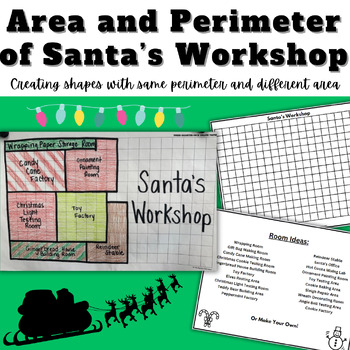Area and Perimeter of Santa's Workshop | Area and Perimeter Center Activity
Grade Three with Mrs C
15 Followers
Grade Levels
2nd - 4th
Subjects
Resource Type
Standards
CCSS3.MD.C.5a
CCSS3.MD.C.6
CCSS3.MD.C.7b
CCSS3.MD.D.8
CCSS3.MD.C.7c
Formats Included
- PDF
Pages
7 pages
Grade Three with Mrs C
15 Followers
Description
Need a last minute No-Prep Winter Activity? Look no further!
This area and perimeter activity is perfect whether you are teaching it now, or need your students to review area and perimeter.
Students get to put their creativity to the test! They need to create 7 rooms inside of Santa's Workshop. But there's a catch...all of the rooms must have a perimeter of 20 units. Then they are responsible for finding the area of each room. Then they get to be creative and a tad silly when they name each room! Christmas Light Testing Room! Hot Cocoa Testing Lab! The sky is the limit!
Total Pages
7 pages
Answer Key
N/A
Teaching Duration
45 minutes
Report this resource to TPT
Reported resources will be reviewed by our team. Report this resource to let us know if this resource violates TPT’s content guidelines.
Standards
to see state-specific standards (only available in the US).
CCSS3.MD.C.5a
A square with side length 1 unit, called “a unit square,” is said to have “one square unit” of area, and can be used to measure area.
CCSS3.MD.C.6
Measure areas by counting unit squares (square cm, square m, square in, square ft, and improvised units).
CCSS3.MD.C.7b
Multiply side lengths to find areas of rectangles with whole-number side lengths in the context of solving real world and mathematical problems, and represent whole-number products as rectangular areas in mathematical reasoning.
CCSS3.MD.D.8
Solve real world and mathematical problems involving perimeters of polygons, including finding the perimeter given the side lengths, finding an unknown side length, and exhibiting rectangles with the same perimeter and different areas or with the same area and different perimeters.
CCSS3.MD.C.7c
Use tiling to show in a concrete case that the area of a rectangle with whole-number side lengths 𝘢 and 𝘣 + 𝘤 is the sum of 𝘢 × 𝘣 and 𝘢 × 𝘤. Use area models to represent the distributive property in mathematical reasoning.





